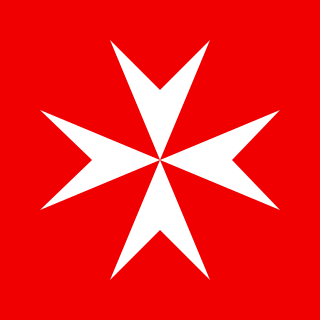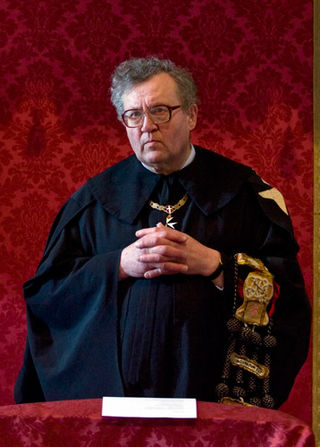Knight of Malta may refer to:
The York Rite, sometimes referred to as the American Rite, is one of several Rites of Freemasonry. It is named for, but not practiced in, York, Yorkshire, England. A Rite is a series of progressive degrees that are conferred by various Masonic organizations or bodies, each of which operates under the control of its own central authority. The York Rite specifically is a collection of separate Masonic Bodies and associated Degrees that would otherwise operate independently. The three primary bodies in the York Rite are the Chapter of Royal Arch Masons, Council of Royal & Select Masters or Council of Cryptic Masons, and the Commandery of Knights Templar, each of which are governed independently but are all considered to be a part of the York Rite. There are also other organizations that are considered to be directly associated with the York Rite, or require York Rite membership to join such as the York Rite Sovereign College but in general the York Rite is considered to be made up of the aforementioned three. The Rite's name is derived from the city of York, where, according to one Masonic legend, the first meetings of Masons in England took place.

The Sovereign Military Order of Malta (SMOM), officially the Sovereign Military Hospitaller Order of Saint John of Jerusalem, of Rhodes and of Malta, commonly known as the Order of Malta or Knights of Malta, is a Catholic lay religious order, traditionally of a military, chivalric, and noble nature. Though it possesses no territory, the order is often considered a sovereign entity under international law.

The Most Distinguished Order of Saint Michael and Saint George is a British order of chivalry founded on 28 April 1818 by George, Prince of Wales, the future George IV, while he was acting as prince regent for his father, King George III.

The Order of St John, short for Most Venerable Order of the Hospital of Saint John of Jerusalem and also known as St John International, is a British royal order of chivalry constituted in 1888 by royal charter from Queen Victoria and dedicated to St John the Baptist.

The Maltese cross is a cross symbol, consisting of four "V" or arrowhead shaped concave quadrilaterals converging at a central vertex at right angles, two tips pointing outward symmetrically.

The Great Siege of Malta occurred in 1565 when the Ottoman Empire attempted to conquer the island of Malta, then held by the Knights Hospitaller. The siege lasted nearly four months, from 18 May to 12 September 1565.

The Bailiwick of Brandenburg of the Chivalric Order of Saint John of the Hospital at Jerusalem, commonly known as the Order of Saint John or the Johanniter Order, is the German Protestant branch of the Knights Hospitaller, the oldest surviving chivalric order, which generally is considered to have been founded at Jerusalem in 1099.

The Knights Templar, full name The United Religious, Military and Masonic Orders of the Temple and of St John of Jerusalem, Palestine, Rhodes and Malta, is a fraternal order affiliated with Freemasonry. Unlike the initial degrees conferred in a regular Masonic Lodge, which only require a belief in a Supreme Being regardless of religious affiliation, the Knights Templar is one of several additional Masonic Orders in which membership is open only to Freemasons who profess a belief in Christianity. One of the obligations entrants to the order are required to declare is to protect and defend the Christian faith. The word "United" in its full title indicates that more than one historical tradition and more than one actual order are jointly controlled within this system. The individual orders 'united' within this system are principally the Knights of the Temple, the Knights of Malta, the Knights of St Paul, and only within the York Rite, the Knights of the Red Cross.
Order of Saint John or Knights Hospitaller is a chivalric order of the Crusades and early modern period, after 1530 also known as "Knights of Malta"

The Order of Knights of the Hospital of Saint John of Jerusalem, commonly known as the Knights Hospitaller, was a medieval and early modern Catholic military order. It was founded in the Kingdom of Jerusalem in the 12th century and had headquarters there until 1291, thereafter being based in Kolossi Castle in Cyprus (1302–1310), the island of Rhodes (1310–1522), Malta (1530–1798), and Saint Petersburg (1799–1801).

Fra' Robert Matthew Festing GCStJ OBE TD DL was an English Roman Catholic official who was the Prince and Grand Master of the Sovereign Military Order of Malta from 2008 until his resignation on 28 January 2017, following a dispute with the Vatican.

George William Vella is a Maltese politician who has served as president of Malta since 2019. A member of the Labour Party, he previously served as deputy prime minister of Malta and foreign affairs minister from 1996 to 1998 under prime minister Alfred Sant. In 2013, he returned as foreign affairs minister, an office he held until 2017 under prime minister Joseph Muscat.

Fra' Giacomo dalla Torre del Tempio di Sanguinetto was the Prince and 80th Grand Master of the Sovereign Military Order of Malta. Born in Rome to a noble family with extensive ties to the Vatican, he completed his studies at the Sapienza University of Rome and taught at the Pontifical Urban University. He joined the Order in 1985 and took full vows in 1993 to become a Knight of Justice. Dalla Torre served two separate stints as interim leader of the Order, from February to March 2008 and again from 2017 until 2018. He was elected Grand Master of the Order on 2 May 2018 and served until his death. During his time in office he endeavoured to repair the Order's relations with the Vatican, which had been strained since Pope Francis ordered his predecessor to resign.
The orders, decorations, and medals of the Holy See include titles, chivalric orders, distinctions and medals honoured by the Holy See, with the Pope as the fount of honour, for deeds and merits of their recipients to the benefit of the Holy See, the Catholic Church, or their respective communities, societies, nations and the world at large.

Fra' Jean "Parisot" de (la) Valette was a French nobleman and 49th Grand Master of the Order of Malta, from 21 August 1557 to his death in 1568. As a Knight Hospitaller, joining the order in the Langue de Provence, he fought with distinction against the Turks at Rhodes. As Grand Master, Valette became the Order's hero and most illustrious leader, commanding the resistance against the Ottomans at the Great Siege of Malta in 1565, sometimes regarded as one of the greatest sieges of all time.

The Raid on Żejtun, also known as The Last Attack, was the last major attack made by the Ottoman Empire against the island of Malta, which was then ruled by the Order of St. John. The attack took place in July 1614, when raiders pillaged the town of Żejtun and the surrounding area before being beaten back to their ships by the Order's cavalry and by the inhabitants of the south-eastern towns and villages.

The flag and coat of arms of the Sovereign Military Order of Malta, or the Jerusalem flag, display a white cross on a red field, ultimately derived from the design worn by the Knights Hospitaller during the Crusades.
A bailiff was a high official in the Knights Hospitaller who directed one of its bailiwicks abroad or one of the national associations ("tongues") at its headquarters.

The French invasion of Malta was the successful invasion of the islands of Malta and Gozo, then ruled by the Order of St. John, by the French First Republic led by Napoleon Bonaparte in June 1798 as part of the Mediterranean campaign of the French Revolutionary Wars.
The Chapter General of the Order of Malta is the legislative body of the Sovereign Military Order of Malta. The Constitution describes it as "the supreme organ of governance of the Order." It meets every six years, mostly recently on 1-2 May 2019.